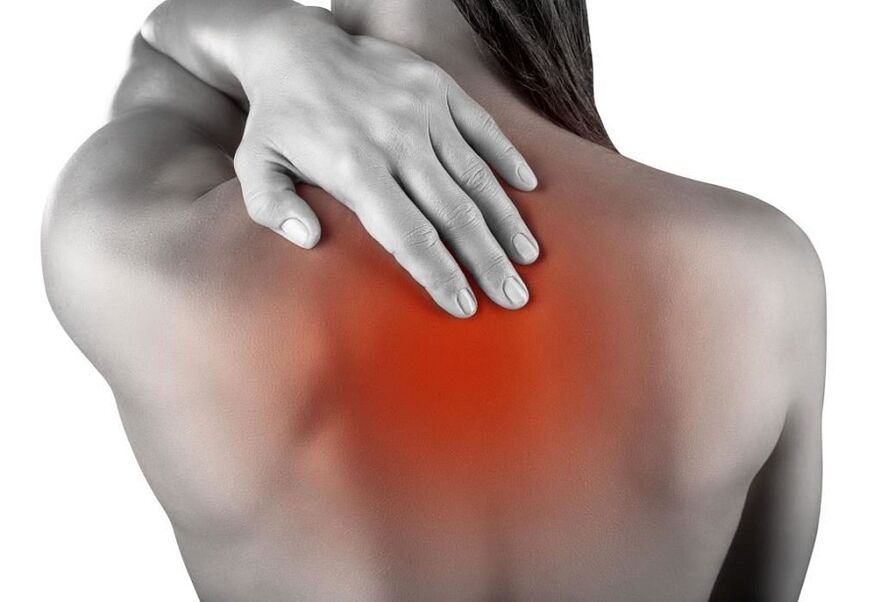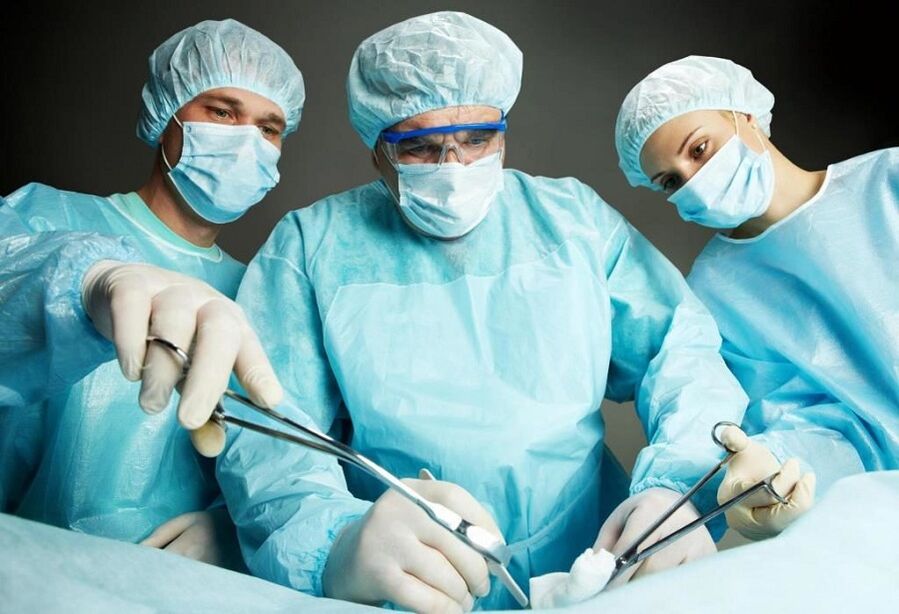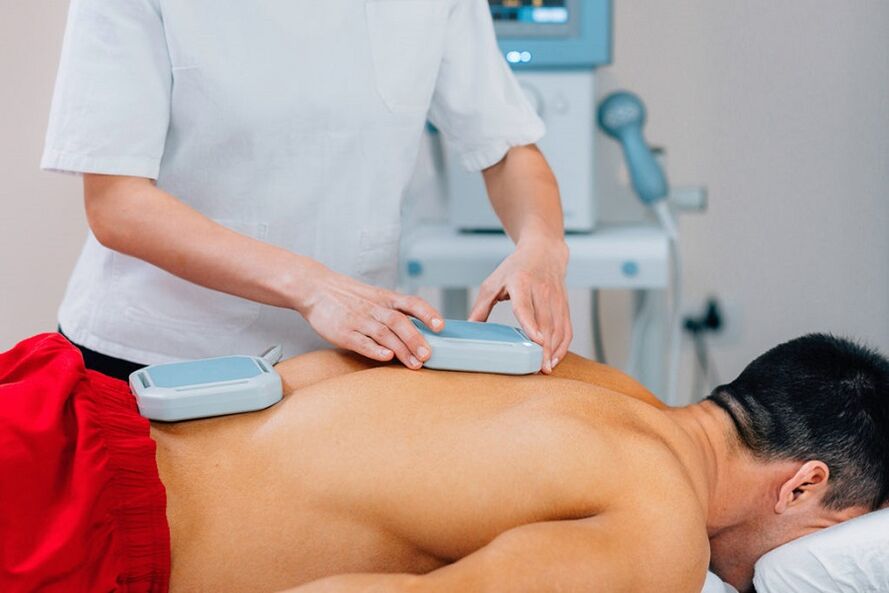In the modern world, it is not just humanity that is progressing.Unfortunately, the diseases that affect humans are also in constant motion and development.
Two decades ago, symptoms of osteochondrosis of the thoracic spine were rare, often in older people.Now the age categories of patients have expanded significantly and include women, men and children of various ages.
The rarity of the manifestations of this disease is based on the fact that the thoracic part of the vertebral region is inactive, which excludes various injuries and damage.
With osteochondrosis of the thoracic spine, the tissue of the bones and cartilage of the spine undergoes serious changes that lead to a violation of their integrity.

If you do not contact a specialist in time, irreversible changes appear, which can only be stopped by surgery.
In the chain of disease development, the skeletal system of the spine comes first, followed by the cartilage formations, ligaments and muscles of the spine.
When osteochondrosis is diagnosed at a young age, premature aging of the musculoskeletal system begins.
There are 4 degrees of development of osteochondrosis of the thoracic spine according to symptoms and treatment, on which the patient's well-being depends:
- Degree.Symptoms are mild or completely absent.Overhangs appear.
- II grade.Intervertebral discs lose their elasticity and height.There is a loss of stability in the spine.The first pains appear.
- III grade.At this stage, hernias are identified with severe pain.
- IV degree.The bone tissue of the spine is destroyed due to the complete deprivation of the intervertebral discs of their basic functions.

Symptoms and signs
The signs of osteochondrosis of the thoracic spine depend on the gender, the degree of development of the disease and the mobility of the patient.Most symptoms appear with certain degrees of stress and fatigue, as well as with prolonged stay in the same position.
How does thoracic osteochondrosis manifest itself:
- Chest pain, which is particularly severe during prolonged periods of inactivity.
- There is a feeling of pressure in the middle part of the back.Deep inhalations and exhalations are also difficult.
- Pain caused when movements related to the spine are included in physical activity.Hand movements, bending, turning.
- Chronic back pain.
- Neurological disorders of certain parts of the body, manifested by numbness.
- Increased sensitivity of certain areas of the skin (so-called goosebumps).
- Unpleasant sensations in the lower extremities.
- Due to vascular damage in thoracic osteochondrosis, local symptoms appear on the skin in the form of peeling.The changes also affect the nails.
- Reproductive disorders and decreased libido may occur.
Symptoms may also differ by gender.The signs of thoracic osteochondrosis in women are somewhat different from those in men.
Symptoms of thoracic osteochondrosis in women:
- Local pain syndrome in the area of the affected disc.
- False symptoms of diseases of internal organs arising during innervation of the pinched nerve.
- Compression symptoms.
Symptoms of thoracic osteochondrosis in men appear much earlier than in women.The rest of the clinical picture is very similar.
Most of the differences appear only in the severity of symptoms, since men lead a much more active lifestyle.
Also, thoracic osteochondrosis in women is less pronounced and occurs later due to the protective effect of female sex hormones.
With thoracic osteochondrosis, the symptoms and sensations can be similar to those during the development of heart disease, therefore, during the diagnosis, studies are also conducted on the function of the heart.

Treatment
The chronic course of the disease is different in that an exacerbation can develop at any time, the symptoms of which are very intense.The patient experiences severe back pain and difficulty breathing.
Before treating thoracic osteochondrosis, it is important to understand the nature of the flare-up and the extent of the disease.Usually, the causes of such situations are specific factors:
- Stressful situations.
- Very hard work.
- Prolonged exposure to low temperature environments.
- Weight lifting or active sport.
Treatment is mainly based on an etiological approach.That is, the factor that caused the acute stage is excluded.In severe cases of the disease, a limited daily regimen is recommended.Here are some principles of the approach:
- Low mobility mode.
- A diet containing large amounts of vitamins, minerals and fiber is prescribed.
- Pharmacological treatment of thoracic osteochondrosis.
- Local treatment, including massage (according to indications), use of external forms of drugs with anti-inflammatory action.
- Exercise therapy.Only in cases where the doctor allows it.
- Physiotherapy.
Medicines
Drug treatment of osteochondrosis of the thoracic spine is based on the classical principles of the treatment of pinched nerve fibers.The first step is to relieve the symptoms that cause significant suffering to the patient.
Medicines of choice are prescribed individually, taking into account contraindications and side effects.Non-steroidal anti-inflammatory therapy is considered primary and main.Its results appear from the first day of treatment.
How to treat thoracic osteochondrosis:
- NSAIDs.Medicines are taken orally or given parenterally.They have a number of positive qualities.First of all, they improve the patient's quality of life by restoring his ability to move normally.
Unfortunately, this group of drugs also has a number of negative indicators.Contraindications include gastrointestinal diseases.An absolute prohibition is imposed in the presence of an ulcer or acute gastritis.If kidney and liver function is impaired, drugs require dose adjustment.

NSAIDs are often combined with muscle relaxants.
- Muscle relaxants are a group of drugs that significantly relieve the patient's condition.When an inflammatory process occurs at the vertebral level, a strong muscle spasm of the fibers around the inflamed area occurs.Prolonged spasm also causes severe pain in the area of the part.Muscle relaxants eliminate this spasm, thereby relieving pain.
Taking these drugs is not recommended if the patient is driving a car or other equipment.
- Vitamin complexes.It is used to relieve inflammation in nerve fibers and stabilize nerve membranes.More often than others, B vitamins and nicotinic acid are used.
- Chondroprotective drugs.Combinations of chondroitin with glucosamine at various dosages.
This group of drugs normalizes metabolic processes in joint tissue and has a strong anti-inflammatory effect with glucose.The course of treatment with chondroprotectors is long-term and is repeated periodically.

Side effects are mainly seen in the gastrointestinal tract.This is burping and burping.
For the treatment of thoracic osteochondrosis, special drugs are used in the form of injections.The principles of administration vary.The main method is the introduction of electrophoresis in the physiotherapy room.Also available in cream and ointment form.
For thoracic osteochondrosis, drug therapy is based on the principles of relieving the inflammatory process and releasing the pinched nerve.
It is important to note that even long courses of anti-inflammatory treatment, in the absence of other corrective courses of treatment, will not be able to relieve the patient of suffering for a long time.
If the attending physician recommends massage procedures, then they must be carried out.
Massage
Before the treatment of osteochondrosis of the thoracic spine with massage, a functional diagnosis is made and the first stage of treatment is prescribed, which includes taking anti-inflammatory drugs and muscle relaxants.
This set of measures aims to relieve spasm and inflammation in the area of the affected part.Only after achieving certain results in the first stage can one talk about the benefits of massage.
How to treat osteochondrosis of the thoracic region with massage?
Massage procedures can additionally relieve muscle spasticity and improve blood supply to the damaged area.
- Acupuncture.A procedure where the hands of a specialist act on specific points, improving the blood supply, thus relieving the inflammatory process.It is important to know that pain is not allowed during acupuncture.Acute pain syndrome is an absolute contraindication to such massage.
- Massage the affected part.It gives excellent results by improving blood supply to the entire area.At the same time, the soft tissues begin to actively regenerate, which has a beneficial effect on the treatment.
- Classic massage.Osteochondrosis in the thoracic region due to acute phase symptoms cannot be treated with classical massage.Any vibrations or displacements can cause severe pain.Only after the complete removal of restrictions on motor activity and the inflammatory process can a classic massage be performed.
- Plastic massage.It is indicated for all stages of the disease, it gives excellent results.After 5 sessions, it is recommended to move on to the next type of massage.

Since getting rid of thoracic osteochondrosis is a complex task, the combination of massage with conservative treatment is considered one of the most effective non-surgical treatments.
Physical training
Thoracic osteochondrosis with signs of stages I - II of the disease is treated with physical therapy, which has a beneficial effect on the muscle layers in the area of the affected part, strengthens the ligaments and eliminates the further development of protrusions.
If the stage of the disease is characterized by severe pain, then conservative treatment, massage are carried out first, and only after that - exercise therapy.
What is exercise therapy?It is a complex of therapeutic and preventive procedures that improve the blood supply and stability of the affected part.

There are several exercises that have worked well:
- Raise your arms as you exhale, bend back with a deep breath.It follows a slow arc with the back arched upwards.
- From a seated position, using the back of a chair for support, bend back with your hands behind your head.
- Stand on all fours, bend and bend the back, fixing the highest and lowest possible positions.
- Position – focus on your stomach.Careful bending of the top is performed with an effort to lift the trunk off the floor.
- Exercise boat.
Their effectiveness depends on how diligently the patient does each exercise.
All exercises are repeated 5 to 7 times.Before starting classes, warm up to avoid sprains and injuries.
Traction
What to do if pathology is detected at the initial stage?
In the initial stages of the disease, traction is considered an excellent solution.Through this process the muscle spasm is eliminated and the displaced vertebrae return to their proper position.Spinal deformity is overcome.
What types of attraction are there:
- Dry grip.This process is easier to perform than others.If the disease is detected in the first stage, then a horizontal bar is perfect.If strong displacements and prolonged spasms are observed, then special beds and exercise equipment are used.These tools properly dose the load and its duration.
- Liquid adhesion.It is performed in warm water, which improves blood circulation in the affected part and also, if done correctly, eliminates sudden movements.
With thoracic osteochondrosis, symptoms during treatment with classical regimens may return several times a year.For prevention, traction and exercise therapy are used, which eliminate the risk of protrusions and strong displacements.

Reviews about physical therapy procedures in the stages of remission and after long-term treatment are mostly positive.The recommendations and implementation of these procedures are absolutely justified!
Surgery
What to do if the chosen methods do not produce results?
Due to the wrong approach to treatment, osteochondrosis of the thoracic spine develops according to the symptoms after treatment and makes the patient's life unbearable.This also happens due to the late visit to the doctor.
Unfortunately, if the integrity of the intervertebral disc is compromised and a herniation is diagnosed, surgery is recommended to avoid life-threatening consequences.
After the operation, special elastic products are prescribed and the patient's mobility is limited until full recovery.

Conclusion
Treatment for osteochondrosis in all its stages and with any approaches depends on how osteochondrosis manifests itself, how much tissue is affected and, most importantly, what is the prognosis for certain procedures.Based on these diagnostic aspects, therapeutic measures are initiated.

















































